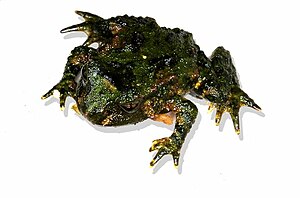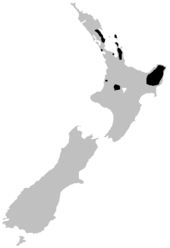Hochstetter frog
| Hochstetter frog | ||||||||||||
|---|---|---|---|---|---|---|---|---|---|---|---|---|

Hochstetter frog ( Leiopelma hochstetteri ) |
||||||||||||
| Systematics | ||||||||||||
|
||||||||||||
| Scientific name | ||||||||||||
| Leiopelma hochstetteri | ||||||||||||
| Fitzinger , 1861 |

The Hochstetter frog ( Leiopelma hochstetteri ) is a species of Froschlurch with only occurrence in New Zealand . It is one of only four species of the New Zealand primeval frogs (Leiopelmatidae).
features
The Hochstetter frog is relatively small, the males reach a head-trunk length of 38 millimeters, the females grow up to 45 millimeters. The frogs have stocky limbs, the front limbs in the males are thicker and more muscular than in the females. They are used to clasp the females during mating. The frogs are mostly brown to olive green in color, but some also show a green color.
The Hochstetter frog has no tympanum and no vocal sacs. Glandular skin is on the flanks, legs and abdomen, but the back is not covered with glands.
distribution
The species occurs in small populations exclusively on the North Island .
Way of life
The Hochstetter frog lives in the shallow water of rivers and streams in shady forests up to an altitude of 800 meters. It is active at night and looks for shelter under stones and wood during the day.
Research history
The species was first described by Leopold Fitzinger in 1861 in the course of evaluating the evidence collected during the Novara expedition . The geologist and later director of the Natural History Court Museum in Vienna, Ferdinand von Hochstetter , brought two specimens of these frogs, which were caught by locals while panning for gold in the streams of the North Island, to Europe. They are still in the museum's type collection today . At the time of the first description, the Hochstetter frog was the only known frog species from New Zealand. In addition to some frog species imported from Australia, there are only four species of the genus Leiopelma in New Zealand .
Individual evidence
- ^ A b B. Gill, T. Whitaker: New Zealand Frogs and Reptiles. David Bateman Limited, New Zealand 1996.
- ↑ DM Green: Antipredator behavior and skin glands in the New Zealand native frogs, genus Leiopelma. In: New Zealand Journal of Zoology. Volume 15, 1988, pp. 39-46.
- ↑ A. Fouquet, GF Ficetola, A. Haigh & N. Gemmell: Using ecological niche modeling to infer past, present and future environmental suitability for Leiopelma hochstetteri to endangered New Zealand native frog. In: Biological Conservation . Volume 143, No. 6, 2010, doi : 10.1016 / j.biocon.2010.03.012 ( digitized version ).
- ↑ LJ Fitzinger: A new Batrachier genus from New Zealand. In: Negotiations of the Imperial-Royal Zoological-Botanical Society in Vienna. Volume 11, 1861, pp. 217-220 ( digitized version ).
- ^ Michael Häupl , F. Tiedemann: Vertebrata 1. Type catalog of the herpetological collection. In: Catalogs of the scientific collections of the Natural History Museum in Vienna. Volume 2, 1978, pp. 7-10.
literature
- Leopold J. Fitzinger : A new Batrachier genus from New Zealand. In: Negotiations of the Imperial-Royal Zoological-Botanical Society in Vienna , Volume 11, 1861, pp. 217–220 ( digitized version , first description ).
Web links
- Leiopelma hochstetteri inthe IUCN 2018-1 Red List of Endangered Species . Listed by: IUCN SSC Amphibian Specialist Group, 2015. Retrieved August 14, 2018.